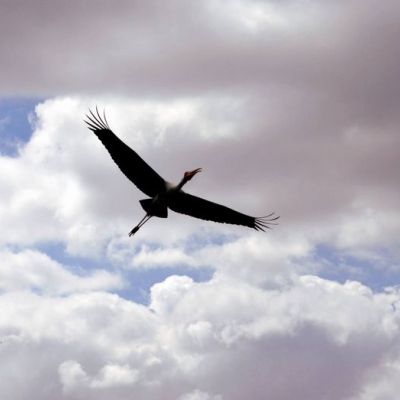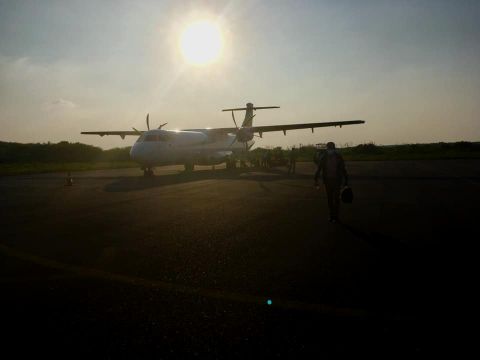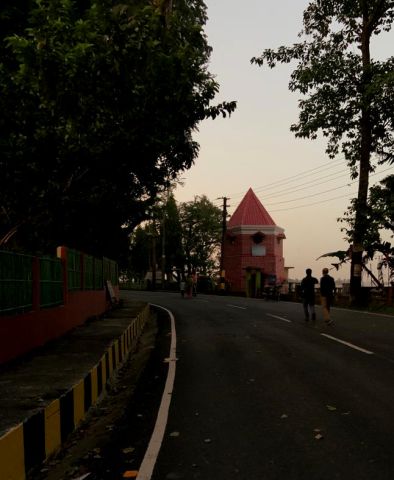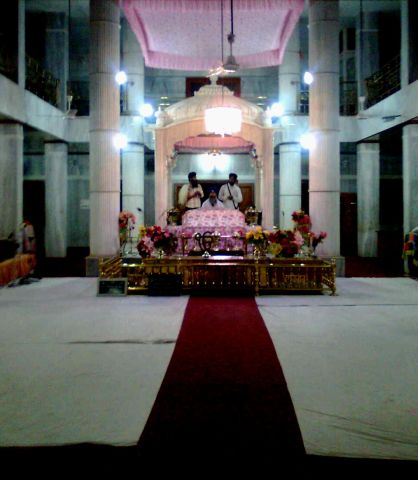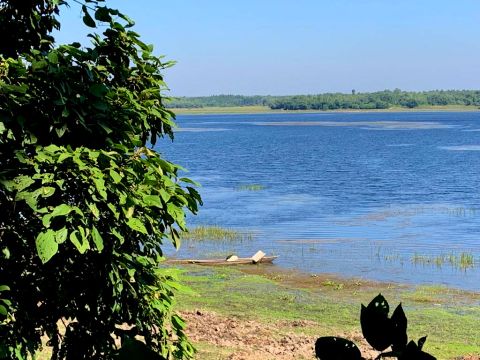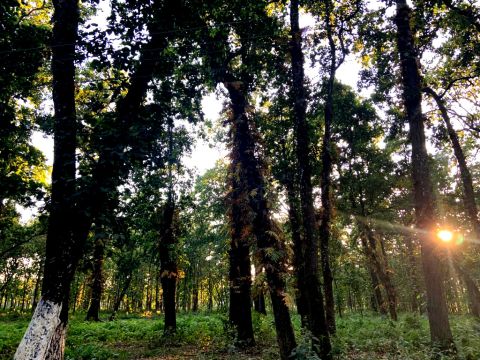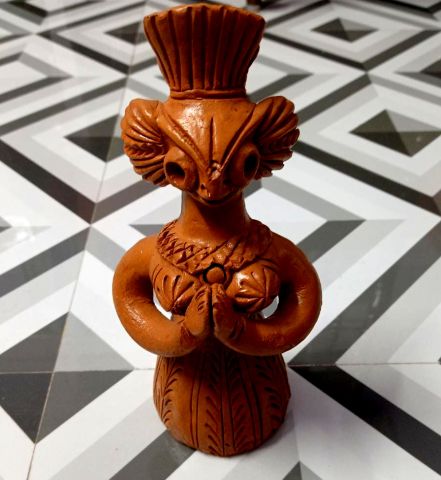Explored the Unexplored
Explored the hidden gem of Dhubri in Assam, where rivers and riverine islands create a mesmerizing landscape. Immersed in the rich culture, witnessed the breathtaking beauty of forests, and uncovered the town's historical charm on this unforgettable journey in Northeast India.
It is about an old district town named Dhubri in the state of Assam. Dhubri is nestled amidst rivers, with three sides surrounded by the Brahmaputra and Gadadhar River. Dhubri is the last town in India that the transboundary river Brahmaputra crosses before entering Bangladesh. We planned to visit Dhubri after Diwali, embarking on a 3-night, 4-day trip to experience the natural beauty of Assam. The recommended hotel in Dhubri is Hotel Brahmaputra. We started our journey to Dhubri from Kolkata airport and arrived at Rupsi airport, which is 16 kilometers away from Dhubri. There are regular flights from Kolkata and Guwahati to Rupsi airport. Rupsi is located near the border of a forest which lies within the boundaries of the UNESCO Natural World Heritage site, Manas National Park. We took a taxi from the airport and proceeded towards Dhubri, enjoying the views of forests, paddy fields, and the Gadadhar River.
Dhubri, one of the most densely populated districts in India, is blessed with beautiful riverine islands, locally known as 'Chor.' The majority of the population on these islands belongs to the Bengali Muslim community. Small vendors from these riverine islands dominate businesses such as poultry, milk, vegetables, and fish in most markets in the Dhubri district. Among these riverine islands, some are permanently inhabited, while others are temporarily inhabited. Temporary islands are formed through the deposition of mud and sand each year when the water level recedes after the rainy season. Once an island is formed, people move there with temporary portable houses and settle. They engage in activities such as vegetable farming, dairy farming, and poultry farming. When these temporary islands are destroyed by floods, the inhabitants relocate their portable houses and search for another inhabitable island. The most admirable characteristic of the people residing in these riverine islands is their ability to work hard and sustain happily under adverse circumstances.
It wouldn't be fair to begin our tour in the 'Land of Rivers' without exploring the river and life around it. Therefore, the next morning, we commenced our tour of Dhubri by witnessing the sunrise on the Brahmaputra River. The best place to view the sunrise is Dhubri Park or Netai Dhubuni Ghat. Dhubri is a small town, and all places are within a 3-kilometer radius. Thus, we went for a morning walk and reached the park before sunrise to enjoy the breathtaking view. We relished a cup of hot tea and a special sweet delicacy called 'Khurma' with moderate sweetness at 'Laxman's Shop.' This shop is situated on the riverbank, just after crossing Netai Dhubuni Ghat.
To explore the Brahmaputra River and its riverine islands by boat, you need to reach one of the piers, such as Panchu Ghat, Jagumaya Ghat, or New Ghat. We took a Toto Rickshaw to reach the pier and hired a shallow boat for an hour at Rs. 1000/-. If you wish to explore the riverine islands, it's important to inform the boatman in advance.
Our journey began on a happy note as the boatman steered us towards the south. The first riverine island we spotted on our left side was Birsing Village. Intrigued by its size, we disembarked at Birsing since it is one of the largest riverine islands near Dhubri town. Birsing Village not only boasts vegetable and poultry farms but also has its own market. As we continued further south, the next riverine island we came across was Aminer Chor, renowned for its poultry farms and pure milk.
Next, we reached a bifurcation point where the left side of the stream led to Phulbari, a village in the Garo Hills, while the right side stream entered Rangpur, a district in East Bengal, now known as Bangladesh. According to the boatman, it would take approximately two and a half hours to reach the demarcation that separates people of the same ethnicity (Bengali). It was time to make a U-turn, and we moved towards the shore, with Bhasan Chor on our left. One of the most captivating moments for a fish lover is when freshly caught fish from the fishermen is purchased in the middle of the river. Finally, that moment arrived. If luck favors you, you may find the beloved Hilsa fish. However, my husband, father, cousin, and I were not fortunate enough. We reached the shore without any Hilsa fish but with plenty of cherished memories to hold onto in our lives.
After a one-hour break for lunch, we embarked on a town tour in the afternoon. If you are a non-vegetarian, I would recommend exploring fresh small river or bill fish such as Boroli or Korti during lunch.
The places of interest in Dhubri town include Netai Dhubuni Park on the bank of the Brahmaputra River, Gurudwara Shri Guru Tegh Bahadur Sahib, and Dargaha. We hired a Toto Rickshaw for sightseeing and started our tour from Netai Dhubuni Park.
Previously, Dhubri was a part of the Goalpara district. However, it has now become a separate district of Assam. In 1879, the British Government shifted the headquarters of the Goalpara district to Dhubri. As a result, Dhubri became an important administrative center, and today, it boasts several attractions that reflect its colonial past. The main attractions in Dhubri town are the offices and bungalows that were built during the British rule. These structures stand as reminders of the town's historical significance and add to its charm. All of these attractions are situated along the banks of the Brahmaputra River. The park on the bank of the river Brahmaputra, called Netai Dhubuni Park, is named after Netai Dhubuni, who was a laundress of the deity. The character of Netai Dhubuni can be found in the Bengali kavya 'Manasamangal'. It is widely believed that the name Dhuburi originated from the name of Netai Dhubuni, adding an intriguing historical connection to the town.
The next place of interest was the Gurudwara Shri Guru Tegh Bahadur Sahib. This is the place on the bank of the Brahmaputra River where Sikh Guru Nanak met the founder of the neo-Vaishnavite movement, Srimanta Sankardeva, in 1505 AD. In 1966, the 9th Sikh Guru, Tegh Bahadur, visited this place and established the Gurudwara. A large number of Sikh devotees visit this Gurudwara every year on the occasion of Sahidee-Guru-Parav. If you visit the Gurudwara during the evening prayer, you will be offered an extremely tasty sooji halwa made with pure ghee.
During the time of Aurangzeb, Raja Ram Singh, the king of Amber and son of Jai Singh, was sent to conquer the Ahom kingdom. Accompanying Raja Ram Singh on this mission were Sikh Guru Tegh Bahadur, who was a close friend of Raja Ram Singh, and five Sufi Saints, who provided him with moral support. Opposite to Netai Dhubuni park, there is a Mazar Sharif (tomb) of these five Sufi Saints, known as Panchpeer Dargaha. It is noteworthy that people from all religious backgrounds in Dhubri visit this Dargaha to offer their prayers, emphasizing the inclusive and harmonious nature of the place.
We couldn't miss the opportunity to try various sweets made with pure milk in Dhubri. Chipta's sweet shop was highly recommended by the residents of Dhubri as the best sweet shop in town.
We had planned a day tour around 50 kilometers from Dhubri on day 3, so we hired a car for the entire day. Our itinerary included visiting six major tourist attractions: Sareswar Beel, the forests of Bashbari and Tipkai, Mahamaya Temple in Bagribari, Rangamati Mosque in Panbari, the craft village named Asharikandi, and Matiabag Palace in Gouripur.
To ensure a stress-free and smooth experience, we started early in the morning at around 7 AM. We made sure to carry enough drinking water and some dry fruits, as there are no food shops available inside the forest. We planned to have lunch after reaching Mahamaya Dham. Our journey began by entering the forest through Sareswar Beel and later reconnecting with NH17 at Mahamaya Temple after exiting the forest.
Our first stop was Sareswar Beel, a freshwater lake located at the border of the Bashbari forest. Managed by the Fishery Development Corporation, this lake is known for its abundant freshwater fish and serves as a habitat for various local, migratory, and endangered bird species. The serene atmosphere, with the beautiful view of the blue water lake surrounded by hillocks and forests, made this place truly relaxing.
Afterward, we ventured into the deep forests of Bashbari and Tipkai which are located within the boundaries of the UNESCO Natural World Heritage site, Manas National Park, known for its rich biodiversity. As we immersed ourselves in the dense forest, we had the incredible opportunity to learn about the tribal life and culture that thrives in this region.
During our exploration, we couldn't resist trying a delightful traditional sweet called 'Bhapa Pitha' from the Bashbari market, which is a specialty of the Bodo tribe. This mouthwatering treat is made by steaming rice flour and filling it with a layer of coconut paste, sesame seed paste, and jaggery. The combination of flavors was truly exquisite.
While we were in the area, we came across three talented women who were skillfully weaving 'Dokna,' the traditional attire of the Bodo tribe, right in the courtyard of their own house. It was fascinating to witness their craftsmanship and dedication to preserving their cultural heritage. We took the opportunity to engage in a friendly conversation with the 'Bhapa Pitha' seller and the three 'Dokna' weavers, exchanging stories and gaining insights into their way of life.
Our time spent in the forests was not only a captivating natural experience but also a chance to appreciate the cultural richness of the Bodo tribe. It was a memorable encounter that deepened our understanding of the region's heritage.
The forest road meets National Highway 17 near the famous Hindu pilgrimage site, Mahamaya temple. Goddess Mahamaya, the deity of Kacharies tribe, is now worshiped by all Hindus in Assam. The temple is on a hillock. The view of the paddy field and forest from the top of the hill is mesmerizing. On the way to Dhubri from Mahamaya temple, you will come across Rangamati Mosque, Asharikandi, and Matiabag Palace.
Rangamati Mosque, built in the 17th century by Hussain Shah, the Governor of Bengal, served as the border control post for the Koch rulers during the Koch regime and the invasion of the Mughal army in Assam. It functioned as the prayer hall for Mughal soldiers. Additionally, during the Mughal invasion in Assam, an idgah and a deep well were constructed. Local villagers believe that the deep well had a long tunnel inside, which could have been used for escape if the Mughal army were to attack.
Our next stop was Asharikandi, a craft village situated on the banks of the Godadhar River, a tributary of the Brahmaputra. In the 19th century, the king of Matiabag patronized a few families of the pottery community from East Bengal. These families continued their profession and gave birth to Assamese terracotta art and culture. Today, more than 80% of the families in this village earn their livelihood by selling terracotta and pottery items in national and international markets. We had the privilege of meeting a senior artisan in Asharikandi who showed us his many awards and shared photographs from his visits to different countries to showcase his craftsmanship.
Our final destination on the one-day tour was Matiabag Palace. This beautiful palace is located on Matiabag Hill near Gauripur. Gauripur was established by Raja Pratap Chandra Barua, the Zaminder of Rangamati, who later shifted his Zamindari from Rangamati to Gauripur. Matiabag Palace served as the hawakhana (resting place) for the family of the Gauripur Raja. It was the residence of two famous personalities: Pramathesh Chandra Barua, the founder of the Indian film industry, and Pratima Barua Pandey, a renowned Goalpariya folk singer who received the Padma Shri award.
Our tour concluded with a view of the majestic Kanchenjunga from the returning flight to Kolkata. The golden water ripples at sunrise on the River Brahmaputra and the enchanting sunsets peeking through the trees in the forest always beckon me to visit Dhubri and spend a few days in the serenity of nature.


